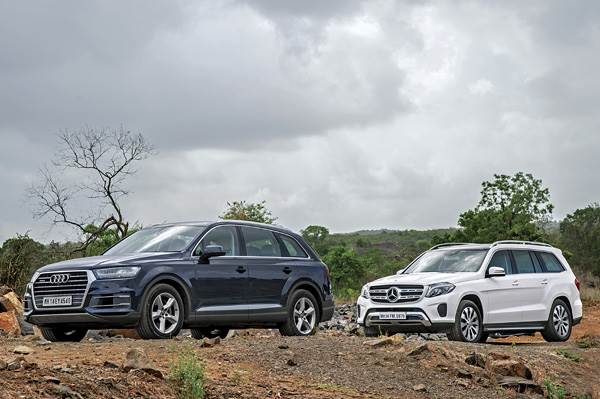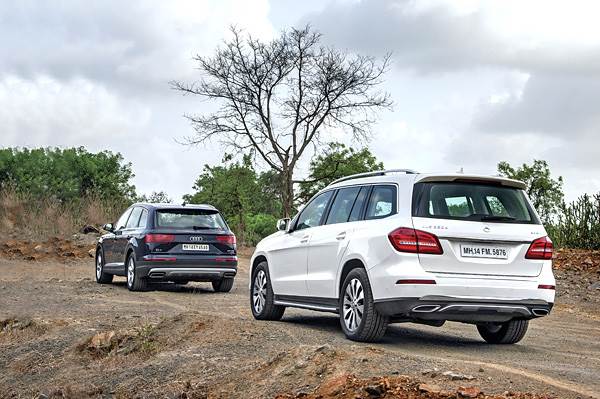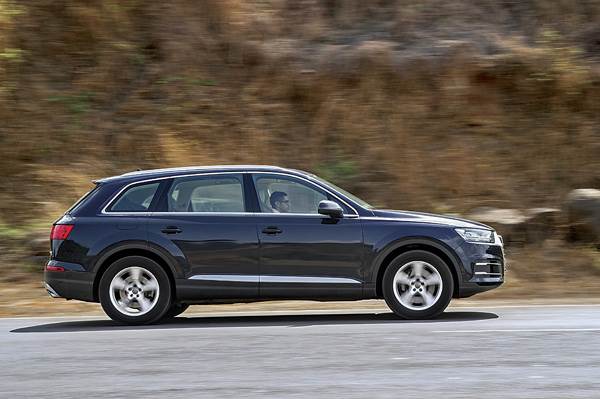The sight of a Mercedes-Benz GLS and the Audi Q7 together is usually the sign of a high profile gathering. These are, after all, the very vehicles that ferry a bunch of India’s politicians, industrialists and celebrities. In fact, it’s not unusual to see these SUVs without a posse of bodyguards and/or page 3 photographers surrounding them.
To formally introduce the contenders, the Mercedes GLS 350 d is the updated version of the older GL. It’s got a new face, revamped cabin, more tech and also a new 9-speed gearbox. The Q7 45 TDI, on the other hand, is the fantastic second-generation model that was launched in India late last year. The Audi is currently the benchmark among large SUVs for performance, comfort, refinement and technology. Has the Q7 met its match in the GLS? Thankfully, we are not on anyone’s hit list and nobody is interested enough in seeing our mug on the tabloids either, so, we can get to the serious job of finding the better SUV without distraction.
Size does matter
In India, where the size of your vehicle determines right of way, the GLS should be automotive royalty. Well over 5-metres long and 1.8-metres tall, the GLS is a large, large vehicle. Merc’s designers have softened front-end styling on the GLS but it still looks every bit an imposing SUV. The oversized three-pointed star sits loud and proud on the twin slatted grille, the chrome scuff plate adds bling to the new bumper and the restyled LED headlights get Merc’s sweeping LED DRL treatment. In its journey from GL to GLS, the big Merc has also gained full LED tail-lamps and a reprofiled rear bumper. The basic shape, though, is the same as the GL which is no bad thing. The trademark upright D-pillar look is quite handsome if a touch old school.

On the contrary, old school is not a phrase you can use to describe the new Q7’s design. The Q7 is as sharp, edgy and modern as they come. The large single piece grille up front is the focal point of the design while the rest of the body is made of simple geometric shapes. It’s all very clean, very contemporary. The level of detailing on the LED lights is brilliant too, especially how the indicators function by glowing in the direction of the turn. But there are many out there who feel the rake of the rear windscreen is too estate-like and, in general, that the new Q7 has lost the visual mass of the old one. The tight surfacing does make the Q7 look a bit smaller than its 5-metre-plus length and 1.7-metre height would suggest, more so in the company of the supertanker that is the GLS.
Back-seat drivers
Both of these SUVs may offer three rows of seating but it’s the middle seat that owners typically occupy. So, it’s important to note that entering and exiting the GLS’ high-set cabin requires use of the footboard and, in that sense, isn’t the most elegant ways to step onto the red carpet. But once inside, you sit at a commanding height and the well-cushioned middle row really feels like a seat of power. There’s massive leg space and that’s despite the fact that these seats don’t slide back as they do on the Q7. What’s no less amazing is that the third row is also a perfectly habitable space for adults. Access to the back, expectantly, is average but sufficient headroom and reasonably comfy seating position makes the GLS a proper seven-seater.

Unfortunately, this leads us to one of the Q7’s biggest weaknesses – the odd position of the spare wheel and its impact on third-row usability. The space saver unit is mounted vertically behind the middle row which means you lose the use of one of the two-third row seats. In effect, it’s a choice between carrying a spare wheel or a seventh passenger. In either case, the Q7’s third row is fair for short distances but cannot match the GLS for comfort or room. It’s a closer match when we shift focus to the middle row. The seat is positioned at the right height so you can literally just stroll in and there is GLS-rivaling legroom with the seats pushed all the way back. If only the seat base offered a bit more by way of thigh support.
Still, overall comfort is more than a function of just how the seats fit you. Ride quality is a vital part of the mix and it is here that the Q7 impresses more than the GLS. The Audi tackles commonly encountered low-speed imperfections with a certain grace and the air suspension feels more absorbent on the whole. Up the pace, however, and you will experience noticeable up-down movement. The thing is, even switching to the firmest of the Audi’s damper modes (Dynamic) doesn’t help completely arrest the motion. Comparatively speaking, though, there is more body movement in the big Merc, even some side-to-side motion, and it’s not just restricted to highway speeds either. You can play around with the Merc’s suspension settings all you like but the air springs won’t deliver the same finesse at city speeds as the Q7’s. You can feel the bumps a bit more and, though the occasional shudder isn’t disturbing, you can’t miss it either.
From the captain’s chair
It’s when I get behind the wheel of both SUVs myself do things start really going the Audi’s way. For one, what a cabin! Like the exterior, the Q7’s interior is cutting edge and that very sedan-like, low-set dashboard, in particular, is a big departure from the SUVs of old, ahem, like the GLS. Attention to detail is also at another level. Things like how the door pockets light up if you so much as put your hand in them or how the surface of the small climate-control buttons are actually touch-sensitive just make the cabin feel so special. And then there’s the fabulous fully digital high-res instrument cluster (Audi calls it Virtual Cockpit) that can be usefully set to display GPS maps so you don’t need to rely on the 7-inch central screen for directions. In addition, the front seats are comfy, the infotainment system is easy to use and visibility is really good, all of which add up to make the Q7 an SUV very easy to get comfy with.

For its part, Mercedes has done a fair bit to bring the old GL’s cabin into the present with the GLS. The GLS gets a new and rather large 8-inch centre screen, a reworked centre console and even a rotary selector called Dynamic Select to switch between the five driving modes on offer. There’s also the latest version of Merc’s Comand infotainment system onboard which includes Apple CarPlay and also gives you the option to browse the internet (when stationary) or hear internet radio channels through
a paired phone’s 3G/4G network. However, the interface isn’t as nice as the Audi’s, feeding inputs via the click and rotary controller isn’t perfectly intuitive and at times, the system is also slow to respond to commands. Of the other things, the dash itself is neat but why must there be so many buttons on the centre console? On the matter of buttons, the familiar power window switches instantly connect the GLS to the older lot of Mercs. What we won’t complain about is the old-world Mercedes quality inside or the comfort offered on the front seats. To sum up, the driving environment in the Merc has the warmth of a quaint cottage while that of the Audi has the contemporary cool of a glitzy new-age office space.
Battle of the V6s
Both the Mercedes and Audi feature 3.0-litre, V6, turbo-diesel engines. The Merc’s 258hp and 620Nm better the Audi’s 249hp and 600Nm but then again, the Q7 is 200kg lighter than the 2,455kg GLS. If you do the math, then, you’ll find the Q7 has the more favourable power-to-weight and torque-to-weight ratios. And the numbers translate to a significant difference in real-world performance too; because where the GLS is brisk for a large, diesel seven-seat SUV, the Q7 is shockingly fast. The Audi races from 0-100kph in just 6.95 seconds or a full 1.26 seconds sooner than the Merc! Stomp on the throttle and you’ll also find the Q7 quicker through the gears.

Even when you go easy, the Q7 feels light on its feet and more alert. You can switch the engine and gearbox to Dynamic to add more, well, dynamism but there’s enough ready thrust in Comfort too. Gearshifts on the eight-speed gearbox are also fluid and timely, and in normal driving, you’ll rarely ever hear more than a cultured hum from the engine bay. The Q7’s V6 is quieter than the GLS’ and this is really a huge achievement because the Merc unit is itself silken smooth.
The GLS’ powertrain is likeable in everyday driving scenarios but once you’ve experienced the Q7, you start to pick faults. For instance, you can tell the GLS bunches up its power around 2000rpm, as opposed to the Q7 that gives access from lower down in the rev band and has the more linear power delivery. You can also tell the GLS’ new nine-speed gearbox is that little bit harsher than the Q7’s eight-speed unit in the way it engages. You can dial things up by switching to Sport mode but the truth is, the GLS feels its best when driven in a relaxed manner.
Even out on a twisty road, you won’t be enthused by the idea of rushing the GLS. The steering can be adjusted for weight but even so, this is a large SUV that wants to be driven like a large SUV. Q7 drivers, on the contrary, will be quite pleased with the way the big Audi readily changes direction and actually feels smaller than it is. The electric steering isn’t the last word in offering feel but it is light and easy to twirl. Both SUVs benefit from 360-degree cameras but the Audi additionally gets Park Assist that will automatically steer the car into a detected parking spot. It’s quite the way to make an impression at the golf course.
And not that these SUVs will really see any off-road action, but it’s nice to know they offer the safety net of all-wheel drive, dedicated off-road modes, hill descent control, hill hold assist and suspensions that can be raised to enhance ground clearance.
Luxury liners
If you need your luxury SUV to be the biggest one around or need it to seat seven in good comfort, look no further than the Mercedes-Benz GLS 350 d. It’s got the size, it’s got the image and is a proper seven-seater. It’s quite nice across other parameters as well. But if you’d have noticed a trend over the course of this comparison, it’s that whatever the GLS can do, the Q7 can do better.
True, the Q7 isn’t as convincing a seven-seater as the GLS and the odd spare-wheel positioning is a put-off, but if these are not deal breakers for you, it is the better SUV. There’s a greater sense of occasion in the Q7’s cabin, refinement levels are amazing, performance is junior sportscar good and it’s got the far more sorted ride quality. Crucially, the Q7 has an aura of modernity which you won’t find around the GLS. The Audi feels like the grounds-up new SUV that it is where the GLS can’t quite hide the fact that it’s the facelifted version of an existing model. That the Q7 45 TDI Technology which costs Rs 79.5 lakh (ex-showroom, Delhi) also undercuts the GLS 350 d priced at Rs 81.9 lakh only strengthens it as our pick of wheels for that political conference/boardroom meeting/movie premiere.








Comments
Member Login
Personal Details
No comments yet. Be the first to comment.